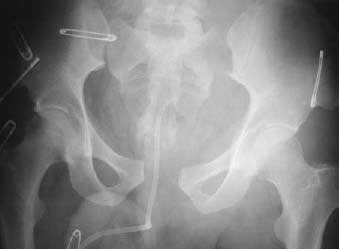CASE 83 Hema N. Choudur, Anthony G. Ryan, and Peter L. Munk A young man who fell from a three-story building was brought to the radiology department on a stretcher, unable to move. Figure 83A Figure 83B An anteroposterior (AP) radiograph of the pelvis (Fig. 83A) shows the pubic symphysis to be widely diastased, with an accompanying disruption and displacement of the right sacroiliac (SI) joint. There is an additional vertical fracture through the left sacral ala parallel to the SI joint. The fractures were successfully treated with internal fixation (Fig. 83B). Pelvic shear fracture type 3. None. Fractures of the pelvis account for 3% of all fractures. The classification of these fractures is based on the direction of the vector and the degree of disruption resulting from applied force. These fractures are classified as lateral compression, AP compression, vertical shear, and combined mechanical injury. These injuries occur as a result of road traffic accidents or falls from a height. A high-impact vector directs the type of injury. The major types of fractures are due to the following:
Pelvic Shear Fractures
Clinical Presentation


Radiologic Findings
Diagnosis
Differential Diagnosis
Discussion
Background
Etiology
Pathophysiology
Clinical Findings
Stay updated, free articles. Join our Telegram channel

Full access? Get Clinical Tree


